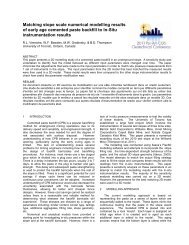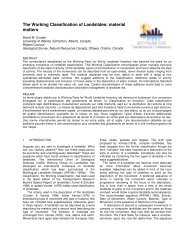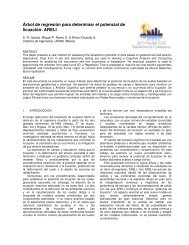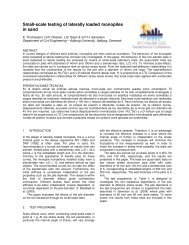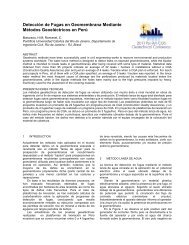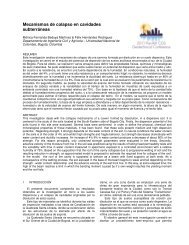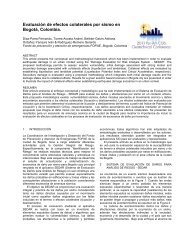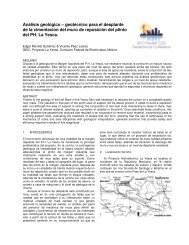MS Word Technical Paper Template
MS Word Technical Paper Template
MS Word Technical Paper Template
You also want an ePaper? Increase the reach of your titles
YUMPU automatically turns print PDFs into web optimized ePapers that Google loves.
disadvantages to this approach; one is related to thepenalty value and the second to satisfying the nopenetrationconstraint.The penalty value can significantly affect thecomputational efficiency of DDA (refer to Khan, 2010,Chapter 3). An inappropriate penalty value may destroythe conditioning of the global stiffness matrix, thusaffecting the convergence of the solution. In addition, it isdifficult to estimate an appropriate penalty value for anarbitrary problem. Alternative approaches such as theclassical Lagrange multiplier method and the augmentedLagrange method also have some disadvantages. Theclassical Lagrange multiplier method adds a gapparameter for each contact, creating a larger system ofequations and the augmented Lagrange method requiresmore iterations to reach convergence, increasing thesolution time and consequently, the computational cost.In DDA-Shi, the no-penetration contact constraint isimposed at each contact point. To satisfy this constraint,the iterative solver proceeds until there is no penetrationat any contact point. Achieving zero-penetration isimpractical. In order to avoid this problem, Shi defined apenetration control parameter or penetration tolerance (f 0).Contact convergence and the final solution largely dependon the value of f 0. Very small tolerance values can lead tofluctuation of results or even divergence of the solution,and large tolerance values may produce incorrect contactforces. In addition, it is difficult to determine an acceptabletolerance value for an arbitrary problem.In addition, satisfying the no-penetration constraint atevery contact point is a time-consuming process becauseof the need to form and solve a large system of equationsusing an iterative process. The no-penetration approachmay exhibit fluctuating divergence for problems involvinglarge numbers of blocks or contact points (Khan, 2010,Chapter 3). It has been shown that the number of opencloseiterations required for contact convergence in eachtime step dramatically increases for problems involvingmore than 500 blocks. As the number of open-closeiterations increases the computational cost also increases.These aforementioned disadvantages make DDA’shard contact approach computationally expensive.Moreover, the assumption that contacts are infinitely rigidis unrealistic because blocks undergo some localdeformation at contact points that must be accounted for.In this work, we adopted the concept of soft contact byallowing interpenetration or overlapping of the contactingblocks (DDA-SC). To do so, a normal contact spring withfinite stiffness is used to represent the measurablestiffness at a contact point (see Fig. 1) Details ofimplementation are discussed in (Khan, 2010).Although physically, overlapping andinterpenetrations of blocks do not occur, small numericalinterpenetration can be interpreted as the actual surfacedeformation at contact points. The joint stiffnessproperties can be obtained from laboratory and fieldtesting.Figure 1. Contact representation in DDA-SC3 EXAMPLESIn this section, the improvements in the computationalefficiency of DDA-SC over DDA-Shi are demonstratedthrough four examples. The examples involve simple caseof block sliding as well as large scale slope stabilityproblems.3.1 Block on an Inclined SurfaceThe benchmark example involves a rigid block sliding onan inclined plane (Fig. 2). The unit depth rectangular blockhas a length 2.0 m and height 1.0 m, and lies on aninclined surface with a slope angle, . The friction anglebetween the block and the inclined surface is specifiedthrough the joint friction angle, . The aspect ratio of theblock and orientation were chosen such that the mode offailure is sliding. Due to gravitational forces, the block onthe inclined plane will accelerate down the plane. In DDA-SC model, normal and shear contact spring stiffness, k nand k s, equal to 50 MPa/m are used.The analytical solution for the displacement, d, of theblock centroid relative to its at-rest position is given by 0displacement ( d) 1 g (sin cos tan ) 2 2 t Using DDA-SC, for five different cases that involve arange of friction angles and a slope angle of 30°, the blockcentroid displacement is computed. The solution iscompared to that obtained from DDA-Shi.The block centroid displacement as a function oftime is shown in Fig. 3. It is observed that DDA-SCcaptures an essential aspect of problem behavior in thesliding process: namely, the displacement reduces as thefriction angle increases. Fig. 4 shows the residual error,Anal DDAe d d , with respect to time. It can be interpretedform this figure that DDA’s solution error grows linearly intime. Although for both the soft and the hard contactapproaches the error is linear with respect to time, thehard contact approach solution deviates more from the(8)




